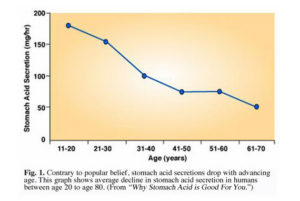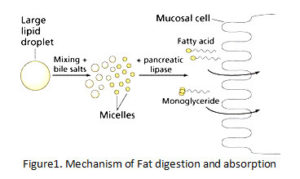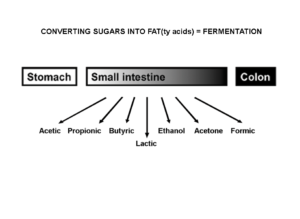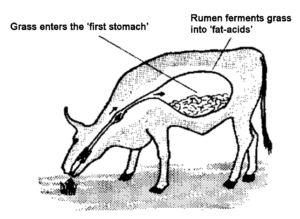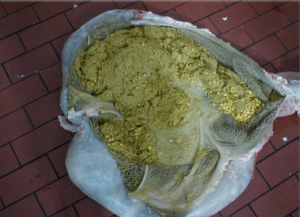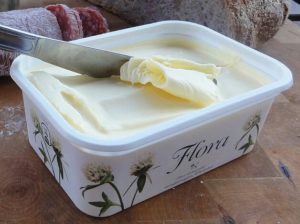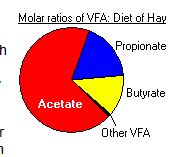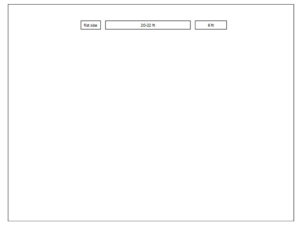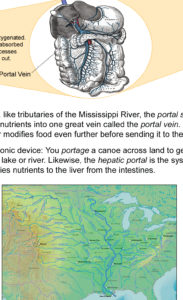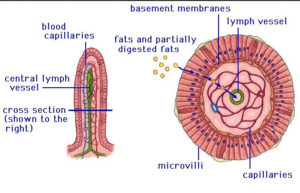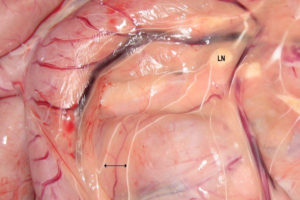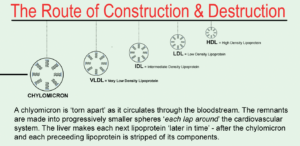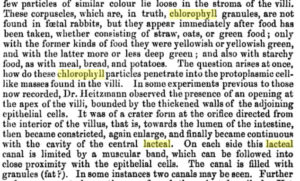Week 12. Gut Physiology, Nutrient Malabsorption, Cognitive Decline, and More
Overview: Transformation and Absorption of Food
Each student illustrates – by hand – a schematic, which begins as a guided and interactive project using the ‘Blank Template’.
Rather than classically explain each digestive organ’s anatomy and physiology, I am presenting the stage by stage progression of one thing:
… food itself transforming within your mouth until it exits as poop. The advantage of doing this is explained in the capsule below titled, Why Focus Only on Food… Chronologically?
- The graphics and information in the capsules below numbered 1 through 5 correspond to the actual chronological ‘flow’ of the transformation of food, which also resembles the finished schematic.
For those who are curious about what such a thing would look like, here’s a finished schematic related to the one created in this presentation.
Why Focus Only on Food - Chronologically?
Why focus only on food – chronologically?
(as it transforms stage by stage)
While I present the timeline of food transformation stage by stage – you detail and fill in the template.
When your hand illustrates the transformation of food through the digestive system from start to finish – you see unfold, the chronological way food breaks down from each agent’s specific action upon it – e.g. of agents:
- HCl, pepsin, and intrinsic factor from the stomach
- bile from the gall bladder
- enzymes from the pancreas
- etcetera as food moves through the intestines where bacteria is the primary agent ‘downline’ – in a healthy gut.
Get it in your head now Digestion is NOT assimilation.
- Digestion pertains to the breakdown of food stuffs into smaller units and the transformation of it within the gut.
- Assimilation pertains to the absorption out of the gut and into the vessels branching off mainly the intestines.
However, digestion and assimilation are synchronized. Nutrients, when broken down correctly – absorb through two different routes* and specific zones along the way ‘down’ the alimentary canal.
* Most dietary fat does not absorb through the intestinal route take by carbs (glucose) and protein (amino acids). Described later.
The unique educational value of the Gut Schematic – enhanced by drawing it yourself – is you learn a chronological and visual sense of food’s transformation through the entire system AND the subsequent routes through which certain nutrients assimilate.
Developing a synchronized sense of digestion and assimilation is almost impossible unless you see it. Drawing it by had and putting it all on one page visually is the key.
Another valuable ‘neuro-cognitive’ thing happens by acquiring a spatial and temporal sense of the whole system. You acquire an enhanced ability to recall through the increased parallel processing* when using your hand and brain together. This also means you really learned it.
* Next week I draw the difference between things which create growth of the synaptic web and things that feed and alter the brain cells’ metabolism and functional energetic state.
- I draw the minor pentatonic scale on a guitar fretboard to explain parallel processing’s effect on brain cells versus things which concretely lead to restoring memory via factors that provide the necessary material and conditions for brain cell metabolism.
- Material being nutritional agents and conditions referring to blood itself, blood flow, and other agents.
1. Stomach
You get the immediate sense that nutrient absorption may be compromised when the stomach is reduced to the size of an egg – as shown in a gastric bypass operation, aka bariatric surgery below. As a rule in this lecture and the next, I’ll generalize this condition as:
Weakened Digestive Power. (similar to ‘Stress’ as the umbrella term for specific forms of stress)
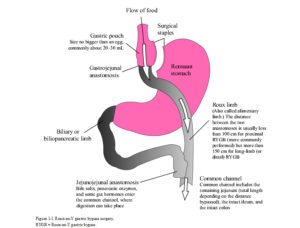
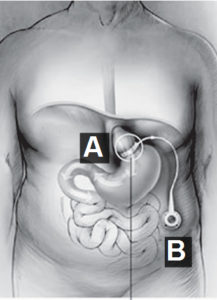 During Normal or Strong Digestive Power:
During Normal or Strong Digestive Power:
or What Should Happen:
1. Stomach cells are stimulated to secrete H+. You need a proton (H+) to make stomach acid.
STOMACH ACID IS: (H+ bonded with Cl-) –> HCl = Hydrochloric Acid)
HCl triggers two critical substances to become active or released in order to break food down:
- Pepsin Activation and Intrinsic Factor Release
1. Pepsin breaks down protein, not HCl. HCl kills bacteria and is the first real immune defense against pathogens, not gut bacteria.
2. Intrinsic Factor is critical for vitamin B12 absorption and the other nutrients bullet pointed below. The next lecture explains nutrient malabsorption’s connection with memory decline, destruction to nerve myelination, decreased red blood cell count, and cognitive decline in general.
- Iron – Fe
- Zinc – Zn
- Calcium – Ca
- Vit D
- Magnesium – Mg
- Copper – Cu
- and more. Listed next lecture.
Stomach Acid Production Decreases with Age, slide below:
This is an ‘age related’ example of Weakened Digestive Power. It should be obvious that low stomach production weakens the mechanisms explained above for proper breakdown and assimilation of food – which we will explore in detail next lecture.
It is no coincidence the nutrients that are malabsorbed (not absorbed properly) under age related weakened digestive power are the same nutrients malabsorbed in gastric bypass patients.
Hence the symptoms of ‘older people’ with these 2 types of weakened digestive power are the same, listed below.
- Low energy. B12 reduction results in lowered red blood cell count. (Lowers oxygen delivery)
- Anemia. Via the combination of lowered Fe absorption and lowered RBC’s.
- Bone Loss/Demineralization
- Nerve / Myelin Destruction… Resulting in loss of coordination and/or balance (ataxia), numbness, tingling, motor function problems in general.
Lack of HCl production – even in so-called healthy elderly people – allows an exponential growth of bacteria in the stomach. Slide below:
The highest bacterial counts at levels 9 and 10 on the y-axis are 100 million and 1 billion times greater than the two very low bacterial count counts at level 1. Each step up multiplies by 10 – thus you count – 10, 100, 1000, 10000, etc, as you go up.
Stomach acid declines precipitously in many people over time. In the next lecture, I present the how problems originating within the stomach and intestines issue a ‘domino effect’ of degenerative and life threatening conditions.
I’ll use heat stroke, hangovers, earthquakes, bariatric surgery, and Crossfit as vehicles for explaining the mechanisms which lead to anemia, bone loss, cognitive decline, blood coagulation in vessels, septic shock, and other problems.
The last slide below shows the whole system and the relative bacterial count in each part of the digestive system.
2. Transition: Stomach to Small Intestine
This transition occurs at the Biliopancreatic Limb (BP Limb) – right after food exits the stomach.
See Biliopancreatic Limb, first slide in stomach section.
- Bilio refers to bile released from the gall bladder
- Pancreatic relates to enzymes released from the pancreas.
Below: first what bile does, then what the pancreas enzymes do to food.
1. Bile’ purpose is to separate fat into small droplets and then make a ball of oil (emulisify fat) in order that oil or fat can mix evenly throughout ‘water’ – rather than float on top. Mayonaise is an example of fat emulsified in a food.
- A Micelle is the form that bile emulsifies the fatty acids into from food – slide below.
Next slide. The fatty acids remain intact as they were in food, and thus are NOT broken down as carbs and protein breakdown into glucose and amino acids respectively.
2. Pancreas releases the ‘ase’ enzymes.
‘ase’ is the suffix which indicates the breakdown of something – like salivary amylase breaks starch down in your mouth.
Amylase: Breaks down carbs into glucose (primarily)
Protease: Protein –> Amino acids
Lipase: Breaks fatty acids off the triglyceride backbone, glycerol. The fatty acids are not split up until they get into cells, much later!
3. Small Intestine
Some Basics of Small Intestine (Listed below the image):
1. 20-23 feet long
2. Villi expand surface area 60,000 times compared to if it was a flat surfaced tube. This surface area is equal to the size of a tennis court.
3. The primary ferments are acetic, propionic, and butyric acid. As indicated by the increased shading, fermentation rate increases as food moves toward the distal end – toward the colon. Fermentation rate corresponds with increased population of bacteria in the same fashion rate of lactate production in a muscle cell is synonymous with the rate of fermenting glucose.
Recall, a muscle cell’s only ferment is lactate (similar to lactic acid). Notice, other products of fermentation include ethanol and acetone (nail polish remover)
4. The slide below shows the exponential increase of bacterial population throughout the entire system – under the right column marked Microbial load per ml.
5. A cow ferments carbohydrates FIRST in its digestive system in the rumen. (Next 3 slides below) The rumen is essentially a large fermentation vat. When a cow ruminates – it lays down, burps up lots of gas, while 15kg of grass ferments cellulose into buytric acid – among other short chain carbon fuel substrates.
6. Terminology
- The ferment is the product of the fuel that ferments.
- Probiotics are bacteria.
- Gut flora is bacteria.
- Prebiotic is the fuel that bacteria feed on, i.e. fermentable carbs.
7. The energy a cow uses later in its cells is not the carbs eaten, but the short chain fatty acids produced.
BY THE TIME FOOD HAS REACHED THE END OF THE SMALL INTESTINE:
1. 90% of carbs as glucose have absorbed.
2. Most amino acids have absorbed. Overcooked meat tends to move on to the colon where it too can be broken down by bacteria. This is called putrefaction. Eating greens are protective against the negatives of putrefaction.
- Glucose and amino acid absorb through the mesentary veins coming off the small intestine, which collectively flow into one the portal vein and to the liver.
3. Fat enters into the lymphatic system as the micelle – moving through an opening on the apex of the villi of the small intestine to the lacteal . Within the lacteals, the fatty acids get repackaged into a large ‘ball of fat’ called a chylomicron. The chyle is the milky-white substance flowing though tiny lymphatic vessels to the largest vessel of the lymphatic system, called the throracic duct.
- This fat goes directly to the heart’s right atrium via the thoracic duct, into the left subclavian vein, into the heart.
- The fatty acids have NOT been broken down as they were in food.
PROBLEMS IN THE SMALL INTESTINE:
1. Antibiotics – repeated use of – kill bacteria and/or creates an imbalance of bacteria upon regrowth. ‘Bad’ nutrition may worsen the situation.
2. SIBO (Small Intestinal Bacterial Overgrowth) happens when bacteria increases their numbers toward the stomach and may even increase in the stomach.
- This increases unwanted fermentation ‘upline’ – and the gas production near the stomach. Just like a cow, the gas creates ‘back pressure’ – resulting in pushing bile acids back to the stomach and possibly the esophagus.
4. Transition: Into the Cecum with Appendix Attached
1. The Cecum: The cecum is the pouch at the beginning of the colon, with the appendix attached out of the way of food stuff flow into the rest of the colon. At this point, food stuff is liquid-like diarrhea. Thus, one primary job of the cecum and the colon is to resorb water in order for a solid stool to form.
A food borne bacterial infection may cause diarrhea, which is helpful in context that ‘speeding up and washing out’ unwanted/infected material is protective. You do not want to absorb food-stuffs which contain harmful pathogens.
2. The Appendix: The appendix is essentially a reservoir for commensal, aka beneficial bacteria. In times of a ‘shortage of bacteria’ perhaps after an infection and bout of diarrhea or an antibiotic ‘wipeout’ the appendix provides bacteria to re-innoculate the colon. Its location avoids the stream of food and harmful pathogens in order to remain free of harm. Perhaps appendicitis results from pathogens that get to the appendix that otherwise ‘normally’ should not reach it.
add source: Biofilms in the large bowel suggest an apparent function of the human appendix.
5. Colon
Some Basics Within the Colon
1. Water resorbs into the body to make a solid stool.
2. The three primary ferments in the colon are:
A. Acetic acid (acetate or vinegar)
B. Butyrate (butyric acid or butter)
C. Propionic acid. Makes the distinct scent and taste of Swiss cheese.
3. Vitamin K2 is produced by bacteria
4. Some B vitamins are produced by bacteria.
Prop: The Blank Gut Template
The Blank Gut Template
Picturing the Grand Concept of Nutrient Assimilation aka Absorption
Below: Link to a time lapse video I created to demonstrate absorption speed of water through a dehydrated plant’s roots to its leaves.
Basics of Carb, Protein, and Fat Absorption:
1. Carbs and protein breakdown primarily into glucose and amino acids respectively.
2. Glucose and amino acids go to the liver via the portal vein, then to the heart and then your general circulation to the periphery of your body.
3. Most fat (long chain fatty acids) do not absorb with glucose and amino acids. They absorb into the lacteals, then into the largest vessel of the lymphatic system – called the thoracic duct.
4. Most fat (long chain fatty acids) do NOT breakdown into smaller units from their original form in the plant or animal.
5. S & M (short and medium) chain fatty acids absorb with glucose and aminos.
Below: The milky white stuff in the very small vessels is chyle (fat) absorbing and channeling to the thoracic duct. Below the chyle pic: Fat in chyle is later transported as a chylomicron, which is a big sphere for transporting fat in blood. Only Long Chain Fatty Acids (LCFA) are carried in chylomicrons. The same goes for LDL and HDL – only LCFA’s are transported in these molecules. Short and Medium Chain Fatty Acids (S&M FA’s) are transported separately by the most abundant protein in the blood called albumin. Albumin is abundant in egg white protein.
Genius Observation from a Past Master
The graphics and information in the capsules numbered 1 through 5 correspond to the chronological order in which food transforms through your digestive tract until it exits as poop and to the 5 columns on the filled-out template.
1. Stomach
You get the immediate sense that nutrient absorption may be compromised when the stomach is reduced to the size of an egg – as shown in a typical gastric bypass operation below. As a rule in this lecture and the next, I’ll generalize this condition as:
Weakened Digestive Power. (similar to ‘Stress’ as the umbrella term for specific forms of stress)

 Normal or Strong Digestive Power:
Normal or Strong Digestive Power:
or What Should Happen:
1. Stomach cells are stimulated to secrete H+. You need a proton (H+) to make stomach acid.
STOMACH ACID IS: (H+ bonded with Cl-) –> HCl = Hydrochloric Acid)
HCl triggers two critical substances to become active or released in order to break food down:
- Pepsin Activation and Intrinsic Factor Release
1. Pepsin breaks down protein, not HCl. HCl kills bacteria and is the first real immune defense against pathogens, not gut bacteria.
2. Intrinsic Factor is critical for vitamin B12 absorption and the other nutrients bullet pointed below. The next lecture explains this nutrient’s connection with memory decline, destruction to nerve myelination, decreased red blood cell count, and cognitive decline in general.
- Iron – Fe
- Zinc – Zn
- Calcium – Ca
- Vit D
- Magnesium – Mg
- Copper – Cu
- and more. Listed next lecture.
Stomach Acid Production Decreases with Age, slide below:
This is an ‘age related’ example of Weakened Digestive Power. It should be obvious that low stomach production weakens the mechanisms explained above for proper breakdown and assimilation of food – which we will explore in detail next lecture.
It is no coincidence the nutrients that are malabsorbed (not absorbed properly) under age related weakened digestive power are the same nutrients malabsorbed in gastric bypass patients.
Hence the symptoms of ‘older people’ with these 2 types of weakened digestive power are the same, listed below.
- Low energy. B12 reduction results in lowered red blood cell count. (Lowers oxygen delivery)
- Anemia. Via the combination of lowered Fe absorption and lowered RBC’s.
- Bone Loss/Demineralization
- Nerve / Myelin Destruction… Resulting in loss of coordination and/or balance (ataxia), numbness, tingling, motor function problems in general.
Lack of HCl production – even in so-called healthy elderly people – allows an exponential growth of bacteria in the stomach. Slide below:
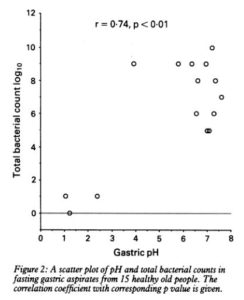 Stomach acid declines precipitously in many people over time. In the next lecture, I present the how problems originating within the stomach and intestines issue a ‘domino effect’ of degenerative and life threatening conditions.
Stomach acid declines precipitously in many people over time. In the next lecture, I present the how problems originating within the stomach and intestines issue a ‘domino effect’ of degenerative and life threatening conditions.
I’ll use heat stroke, hangovers, earthquakes, bariatric surgery, and Crossfir as vehicles for explaining the mechanisms which lead to anemia, bone loss, cognitive decline, blood coagulation in vessels, septic shock, and other problems.
The last slide below shows the whole system and the relative bacterial count in each part of the digestive system.
2. Transition: Stomach to Small Intestine
This transition occurs at the Biliopancreatic Limb (BP Limb) – right after food exits the stomach. See BP Limb, first slide in stomach section.
- Bilio refers to bile released from the gall bladder
- Pancreatic relates to enzymes released from the pancreas.
Below: first what bile does, then what the pancreas enzymes do to food.
1. Bile emulsifies fat into smaller droplets that mix evenly throughout ‘water’ – making an emulsification. Mayonaise is an example of fat emulsified in a food.
A Micelle is the form that bile emulsifies the fatty acids from food – slide below.
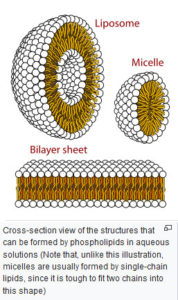 Next slide. The fatty acids remain intact as they were in food, and thus are NOT broken down as carbs and protein breakdown into glucose and amino acids respectively.
Next slide. The fatty acids remain intact as they were in food, and thus are NOT broken down as carbs and protein breakdown into glucose and amino acids respectively.
2. Pancreas releases the ‘ase’ enzymes.
‘ase’ is the suffix which indicates the breakdown of something – like salivary amylase breaks starch down in your mouth.
Amylase: Breaks down carbs into glucose (primarily)
Protease: Protein –> Amino acids
Lipase: Breaks fatty acids off the triglyceride backbone, glycerol. The fatty acids are not split up until they get into cells, much later!
3. Small intestine
Some Basics of Small Intestine (Listed below the image):
1. 20-23 feet long
2. Villi expand surface area 60,000 times compared to if it was a flat surfaced tube. This surface area is equal to the size of a tennis court.
3. The primary ferments are acetic, propionic, and butyric acid. As indicated by the increased shading, fermentation rate increases as food moves toward the distal end – toward the colon. Fermentation rate corresponds with increased population of bacteria in the same fashion rate of lactate production in a muscle cell is synonymous with the rate of fermenting glucose.
Recall, a muscle cell’s only ferment is lactate (similar to lactic acid). Notice, other products of fermentation include ethanol and acetone (nail polish remover)
4. The slide below shows the exponential increase of bacterial population throughout the entire system – under the right column marked Microbial load per ml.
5. A cow ferments carbohydrates FIRST in its digestive system in the rumen. (Next 3 slides below) The rumen is essentially a large fermentation vat. When a cow ruminates – it lays down, burps up lots of gas, while 15kg of grass ferments cellulose into buytric acid – among other short chain carbon fuel substrates.
- The ferment is the product of the fuel that ferments.
- Probiotics are bacteria.
- Gut flora is bacteria.
- Prebiotic is the fuel that bacteria feed on, i.e. fermentable carbs.
7. The energy a cow uses later in its cells is not the carbs eaten, but the short chain fatty acids produced.
BY THE TIME FOOD HAS REACHED THE END OF THE SMALL INTESTINE:
1. 90% of carbs as glucose have absorbed.
2. Most amino acids have absorbed. Overcooked meat tends to move on to the colon where it too can be broken down by bacteria. This is called putrefaction. Eating greens are protective against the negatives of putrefaction.
- Glucose and amino acid absorb through the mesentary veins coming off the small intestine, which collectively flow into one the portal vein and to the liver.
3. Fat enters into the lymphatic system as the micelle – moving through an opening on the apex of the villi of the small intestine to the lacteal . Within the lacteals, the fatty acids get repackaged into a large ‘ball of fat’ called a chylomicron. The chyle is the milky-white substance flowing though tiny lymphatic vessels to the largest vessel of the lymphatic system, called the throracic duct.
- This fat goes directly to the heart’s right atrium via the thoracic duct, into the left subclavian vein, into the heart.
- The fatty acids have NOT been broken down as they were in food.
PROBLEMS IN THE SMALL INTESTINE:
1. Antibiotics – repeated use of – kill bacteria and/or creates an imbalance of bacteria upon regrowth. ‘Bad’ nutrition may worsen the situation.
2. SIBO (Small Intestinal Bacterial Overgrowth) happens when bacteria increases their numbers toward the stomach and may even increase in the stomach.
- This increases unwanted fermentation ‘upline’ – and the gas production near the stomach. Just like a cow, the gas creates ‘back pressure’ – resulting in pushing bile acids back to the stomach and possibly the esophagus.
4. Transition: Into the Cecum with Appendix Attached
1. The Cecum: The cecum is the pouch at the beginning of the colon, with the appendix attached out of the way of food stuff flow into the rest of the colon. At this point, food stuff is liquid-like diarrhea. Thus, one primary job of the cecum and the colon is to resorb water in order for a solid stool to form.
A food borne bacterial infection may cause diarrhea, which is helpful in context that ‘speeding up and washing out’ unwanted/infected material is protective. You do not want to absorb food-stuffs which contain harmful pathogens.
2. The Appendix: The appendix is essentially a reservoir for commensal, aka beneficial bacteria. In times of a ‘shortage of bacteria’ perhaps after an infection and bout of diarrhea or an antibiotic ‘wipeout’ the appendix provides bacteria to re-innoculate the colon. Its location avoids the stream of food and harmful pathogens in order to remain free of harm. Perhaps appendicitis results from pathogens that get to the appendix that otherwise ‘normally’ should not reach it.
add source: Biofilms in the large bowel suggest an apparent function of the human appendix.
5. Colon
Some Basics Within the Colon
1. Water resorbs into the body to make a solid stool.
2. The three primary ferments in the colon are:
A. Acetic acid (acetate or vinegar)
B. Butyrate (butyric acid or butter)
C. Propionic acid. Makes the distinct scent and taste of Swiss cheese.
3. Vitamin K2 is produced by bacteria
4. Some B vitamins are produced by bacteria.

